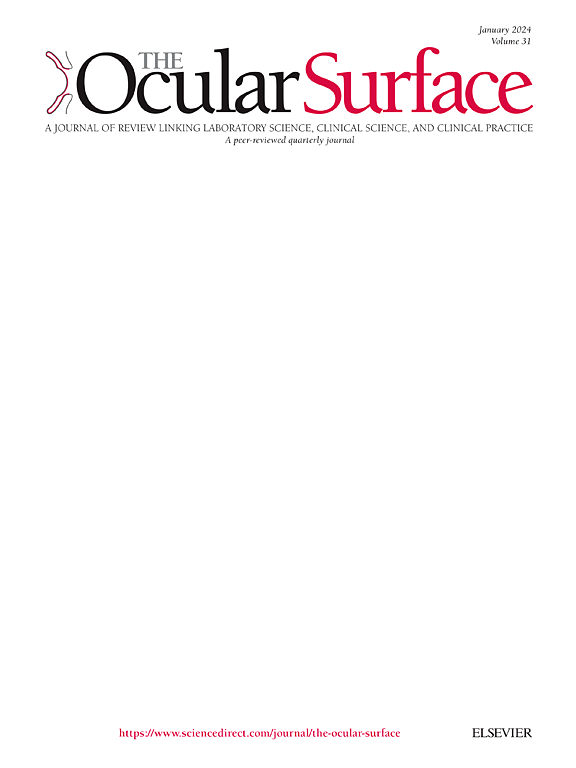Ocular graft-versus-host disease: Experience, incidence, and treatment outcomes at a university-based tertiary care ophthalmology center
IF 5.6
1区 医学
Q1 OPHTHALMOLOGY
引用次数: 0
Abstract
Objective
This study describes the clinical experience, incidence, and outcomes of treating chronic ocular graft-versus-host disease (oGVHD) at a tertiary care ophthalmology center.
Methods
This retrospective analysis included 413 post-hematopoietic stem cell transplant patients. Ocular GVHD was diagnosed using the international chronic oGVHD consensus group criteria. Based on the severity of the initial presentation and the topical treatment received accordingly, patients with definite oGVHD were divided into three groups: Group A received combination of steroids, serum tears, and pooled human immunoglobulin; Group B received steroids and serum tears; and Group C received steroids only. Treatment response was analyzed using Wilcoxon rank-sum and Kruskal-Wallis test.
Results
53 % of patients presented with definite oGVHD manifestations at the initial visit with 16 % of these patients presenting with only ocular manifestations of chronic GVHD. Among those initially categorized as none or probable oGVHD only 18 % progressed to definite oGVHD during the follow-up period. Patients in treatment group A and B showed significant reduction (p < 0.01) in corneal staining at follow-up compared to initial visit. However, corneal staining reduction in treatment group C did not achieve significance (p = 0.06). Visual analogue scale scores decreased in all groups, with treatment group A (p < 0.01), group B (p < 0.01), and group C (p = 0.014) each showing improvement in symptoms at follow-up compared to initial visit.
Conclusion
The high incidence of oGVHD in post-HSCT patients may be related to belated referral to eye care providers. Initiating combinatorial treatment that is based on the severity of oGVHD manifestations results in significant clinical improvement.
眼移植物抗宿主病:一所大学三级保健眼科中心的经验、发病率和治疗结果
目的介绍某三级保健眼科中心治疗慢性眼部移植物抗宿主病(oGVHD)的临床经验、发病率和结果。方法对413例造血干细胞移植后患者进行回顾性分析。眼部GVHD的诊断采用国际慢性oGVHD共识组标准。根据初始表现的严重程度和相应的局部治疗,将明确的oGVHD患者分为三组:A组接受类固醇、血清泪液和混合人免疫球蛋白联合治疗;B组给予类固醇和血清泪液;C组仅接受类固醇治疗。采用Wilcoxon秩和和Kruskal-Wallis检验分析治疗反应。结果53%的患者在初次就诊时表现出明确的oGVHD表现,其中16%的患者仅表现为慢性GVHD的眼部表现。在最初被归类为无或可能oGVHD的患者中,只有18%的患者在随访期间发展为明确的oGVHD。治疗组A、B组患者表现明显降低(p <;与初次就诊相比,随访时角膜染色差异为0.01)。而C组角膜染色减少无显著性意义(p = 0.06)。各组视觉模拟量表评分均下降,A组(p <;0.01), B组(p <;0.01)和C组(p = 0.014)在随访时均显示与初次就诊相比症状有所改善。结论移植后患者oGVHD的高发可能与转诊较晚有关。根据oGVHD表现的严重程度启动联合治疗可显著改善临床。
本文章由计算机程序翻译,如有差异,请以英文原文为准。
求助全文
约1分钟内获得全文
求助全文
来源期刊

Ocular Surface
医学-眼科学
CiteScore
11.60
自引率
14.10%
发文量
97
审稿时长
39 days
期刊介绍:
The Ocular Surface, a quarterly, a peer-reviewed journal, is an authoritative resource that integrates and interprets major findings in diverse fields related to the ocular surface, including ophthalmology, optometry, genetics, molecular biology, pharmacology, immunology, infectious disease, and epidemiology. Its critical review articles cover the most current knowledge on medical and surgical management of ocular surface pathology, new understandings of ocular surface physiology, the meaning of recent discoveries on how the ocular surface responds to injury and disease, and updates on drug and device development. The journal also publishes select original research reports and articles describing cutting-edge techniques and technology in the field.
Benefits to authors
We also provide many author benefits, such as free PDFs, a liberal copyright policy, special discounts on Elsevier publications and much more. Please click here for more information on our author services.
Please see our Guide for Authors for information on article submission. If you require any further information or help, please visit our Support Center
 求助内容:
求助内容: 应助结果提醒方式:
应助结果提醒方式:


